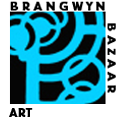
DECORATIVE ARTS
Brangwyn felt that a designer should have imagination, taste, technical knowledge and a sense of public needs – he possessed all of these plus a chameleon like nature and an understanding of architecture. He was not only a polymath but also an artist-craftsman, who could successfully design complete and harmonious interiors and involved himself with the technical background to each discipline. Brangwyn’s exceptional range of achievements included designs for architecture and interiors, furniture, carpets, tapestry, ceramics, glassware and jewellery.
Brangwyn's three mentors, A H Mackmurdo, William Morris and Siegfried Bing may all have influenced Brangwyn's involvement with the decorative arts which appears to date from about 1900. At the same date Brangwyn was becoming more involved with mural painting and if he had become preoccupied with that particular discipline perhaps he would be as renowned today as a designer as for example Charles Rennie Mackintosh or the Vienna Seccessionists whose work was similar.
ARCHITECTURE AND INTERIORS
The defining features of Brangwyn’s interiors were:
- restrained background, acting as a foil to areas of decoration or paintings
- line as the pre-eminent form of expression
- co-ordination of all aspects of furnishing, producing an aesthetic whole (Gesamtkunstwerk)
Brangwyn's major Architectural and Inerior design commissions were:
1899-1900
Lansdowne House, 11-13 Lansdowne Road, Kensington (A2604)
Commissioned by Sir Edmund and Lady Davis to design a complete bedroom interior for Sir Edmund and Lady Davis including murals, wood panelling, furniture, fireplace surround, lighting, metalwork, bedcover and even silver backed hairbrushes (destroyed, a mural panel and some pieces of metalwork exist)
c1902
Thurston & Co Ltd, London (A2608)
Brangwyn was commissioned to design a complete interior decoration for a billiard room by Thurstons – probably for a private client. The artist’s designs included a mural, wood panelling, billiard table, lighting, fireplace surround and occasional furniture.
1905
British Rooms, Venice Biennale (A1337)
Brangwyn was invited by Antonio Fradeletto, General Secretary of the Biennale, to design the British Rooms. Brangwyn painted murals and designed wood panelling and furniture for the rooms, gaining a Gold medal for his work. The solid oak benches he designed are now placed outside the British Pavilion in Venice.
1906
Palazzo Rezzonico, Venice (A2605)
Brangwyn was commissioned to design a dining room interior for Count Lionel Hirschel di Minerbi, which included a painted frieze, furniture and fireplace surround. However the two men disagreed and the scheme never came to fruition.
1907
British Rooms, Venice Biennale (A2606)
The interior remained as it was two years previously, Brangwyn adding new murals, the fate of which is unknown, presumed destroyed.
1904(?)
Temple Lodge, 51 Queen Caroline Street, Hammersmith, studio extension (A2231)
Frank Alford considered Brangwyn's studio one of the largest in London at the time.
1909-1910
Casa Cuseni, Taormina, Sicily (A2607)
Commissioned by Brangwyn’s friend, pupil and patron R H Kitson to design a complete interior decoration for the dining room, including a painted frieze, wood panelling, dining table, chairs, fireplace surround, sideboard and ashtrays. The house remained in the family until 2008.
1912
St Mary the Virgin, Bucklebury, Berkshire (A2238)
Brangwyn designed the sanctuary wall decoration and mosaic reredos (latter since removed).
1913
Brangwyn Room at the Ghent International Exhibition (A2292)
Brangwyn designed the carpet, table and chairs. the murals were from those due to be placed in the Committee Luncheon Room, Lloyd’s Register of Shipping (M2619), Fenchurch Street, London (M2619) together with a new lunette.
1915
Horton House Billiard Room, Northampton (A1178)
George Harold Winterbottom commissioned Brangwyn to paint murals in his billard room and also to design a billiard table and lighting.
1918-1940
The Jointure, South Street, Ditchling (A1820)
Brangwyn converted and extended adjoining cottages to make new studios, added a double storey kitchen/bedroom extension to the main house, added inglenook and tiled fireplaces, metalwork and furniture to the interior and converted other cottages on the land
between 1938-1940. House and Studio in private ownership.
1918-1922
Kyoraku Art Museum, Tokyo (A1827)
Brangwyn was commissioned by the Japanese industrialist, Kojiro Matsukata to design what would have been one of the first museums in Japan and the largest museum of western art outside Europe and the Americas. Unfortunately the project never came to fruition.
1930
Pollard & Co, London (A3305)
Brangwyn was commissioned to design furniture, carpets, ceramics, table glassware, lighting and textiles for two bedrooms, a sitting room and a dining room. Many items from the exhibition exist.
1930-1931
SS Empress of Britain (A1822)
Brangwyn was commissioned by the canadian pacific Line to design the interior of the 1st class dining room, the Salle Jacques Cartier, and two private dining rooms, the Salle Wolfe and Salle Montcalm, including murals, wall panelling, lighting, tables, chairs, furniture and marquetry panels. The vessel was requisitioned as a troop carrier during the war and Brangwyn’s panels were lost when she was attacked by a German bomber plane and submarine in October 1940. Some items of furniture are in a private collection.
1933
Rowley Gallery Façade, 140-142 Kensington Church Street, London (A1854)
Commissioned by Brangwyn’s friend Albert James Rowley to design the exterior of his shop. Brangwyn produced a minimalist facade using glass, Portland stone and carved and pierced teak wood panels.
1935-1945
Brangwyn Estate, London Road, Brighton (A2611)
Brangwyn may have been consulted about the general layout of the estate and the entrance obelisks certainly look similar to pedestals he designed for the Venice Biennale (A2606).
FURNITURE, CARPETS, CERAMICS, GLASSWARE, JEWELLERY
Brangwyn produced over 240 designs for furniture (not all of which were made). The guidelines he set himself were an adaptation of Puginian and Arts and Crafts ideals:
- fitness of form to function
- excellent craftsmanship
- suitability of material to article
- absence of applied ornament disguising structure
- elimination of unnecessary moulding
Apart from specific interior design commissions, Brangwyn designed furniture for the firms J S Henry and Norman and Stacey and paul Turpin made individual items for the artist.
Brangwyn’s carpets often have a central two dimensional design with geometrical abstracted plant patterns, surrounded by borders containing randomly placed motifs. They are more akin to ethnic carpets from the Caucuses, Turkey and Central Asia than with the classical Persian carpets admired by Morris.
Brangwyn was passionate about ‘pots’, as he termed them – he collected Persian, Chinese, Korean and Japanese ceramics and such items appear endlessly in his oils, watercolours and murals. He collaborated with Royal Doulton, Ashtead Potters, Foley Pottery and produced a design for Clarice Cliff’s Bizarre range at A J Wilkinson in 1934.
Brangwyn produced a number of designs for glassware, some of which were produced by James Powell of Whitefriars for the Pollard exhibition. Unfortunately no pieces are known to have survived, but since the glass is not marked or signed in any way, it may be possible that Brangwyn glassware exists but has not been recognized as such, or may have been attributed to Philip Webb or Thomas Graham Jackson, whose designs Brangwyn emulated.
Brangwyn’s jewellery was probably influenced by Colonna and Tiffany and dates from the turn of the century. The items incorporated enamels and semi-precious stones in simple settings, the designs bearing a remarkable similarity to many of the artist’s drawings for ironmongery. Only one brooch is known to exist (private collection, USA).
Examples of Brangwyn's decorative art designs are reproduced below (the number in brackets following the title of each Brangwyn work indicates the number by which the work is identified in the Catalogue Raisonne). Paul Liss has kindly given me permission to use images from his website.
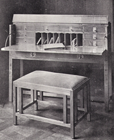 |
 |
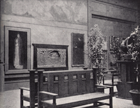 |
| Davis Writing Desk and Stool (F2800), c1900, pwu, photograph from The Studio, April 1900, p173. These items were made for Lansdowne House (A2604). The furniture was probably made of cherrywood with antelope skin upholstery and pierced oxidised silver fittings. | Thurston Billiard Table (F2812), c1902, pwu, photograph from Furst, Decorative Art of Frank Brangwyn, London, 1924, p206. Brangwyn was not the first designer to use non Queen Anne legs on a billiard table, George Walton having designed one for Miss Cranston's Tea Rooms in 1896. The heavy bolts attaching the cushions to the slate bed were covered with finely worked hammered and oxidised metal plates, and the edges of the main legs were decorated with a simple inlay of ebony and ivory, with larger geometrical inlay on the sides of the table. | Venice Biennale (A1337), 1905. The main room measured 2286x1219cm (74x40ft), photograph from The Studio, July 1905. Brangwyn used bleached walnut and placed a horizontal sheld above the skirting, resting on square blocks. The walls were covered with grey fabric, divided by flat profile horizontal and vertical stris ceating a rhythm. The top 1/5th of the wall was painted dark blue and spotted with a stencil pattern. Brangwyn designed four benches placed back to back, a large pedestal, four smaller pedestals and possibly some display cabinets. |
 |
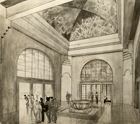 |
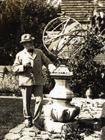 |
| Casa Cuseni, Taormina, Sicily (A2607), 1909-1910, photographed in 1999. The dining room is a 16ft cube. Brangwyn used pecan wood for the furniture and panelling (divided by his signature flat profile horizontals and verticals). He also painted the frieze in situ. The candelabra would not have been Brangwyn's choice of lighting! | Kyoraku Art Museum, Tokyo (A1827), 1918-1920, unexecuted, photograph of entrance hall courtesy of Liss Fine Art. Brangwyn designed the entrance hall as a 36ft cube (probably inspired by Kitson's dining room). He specified teak flooring, grey painted walls, large glazed doorways with stained glass lunettes and a blue and gold mosaic vaulted ceiling. A buff coloured ceramic bowl fountain with a blue edge was to be placed in the centre. Small holes beneath the rim allowed water to trickle into a square pond which would reflect the ceiling and stained glass. | Astrolabe (F3435), c1924, stone base with metal sundial painted blue and gold. Provenance: Brangwyn, Crosby Cook, private collection. Studies: Sketchbook, Royal Academy, London. Brangwyn is reputed to have made both the base and sundial. Photograph courtesy of Liss Fine Art. |
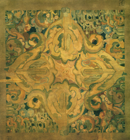 |
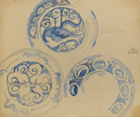 |
 |
| Design 1276 (Plants) (T2879), 1929, Axminster woven carpet manufactured by James Templeton & Co, Glasgow, monogram woven into corner of carpet, five sizes, multiple ownership. The carpet was made specifically to be shown at the Pollard Exhibition, 229 Oxford Street, October 1930 (see photograph of Dining Room below). | Bird Plate (C1762), c1929, pencil and watercolour on paper, 50x56.5cm. Provenance: Edgar Peacock; Moss Galleries; private collection. One of Brangwyn's many sheets of designs for plates produced as a result of the Pollard commission. These were not manufactured but Brangwyn carved the bird logo into one of the roundels on his bedroom door. | Three of Brangwyn's designs for Royal Doulton, left to right: D5034 Harvest (C1804); D5080 (C1809); Harvest; D5033 (C1805), all c1930. The earthenware pots were left the natural buff colour, were dip glazed, and the patterns were formed in the moulds or incised by hand giving the impression of sgraffito. The details were hand painted, Brangwyn allowing the artists a certain amount of autonomy, with the result that each piece is unique. |
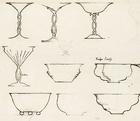 |
 |
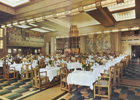 |
| Wine Glasses (G1744), c1929, pencil and ink on paper, 50.5x75.5cm, signed in full b.c. provenance: Edgar Peacock; Liss Fine Art. One of a number of sheets of measured drawings for glass tableware produced as a result of the Pollard commission. Image courtesy Liss Fine Art. | Pollard Exhibition Rooms (A2609), 1930, the dining room, photograph private collection. All elements of theroom were designed by Brangwyn and the furniture was made by E Pollard & Co, the carpets and rugs by Templetons of Glasgow and Mortons of Carlisle, the ceramics by Royal Doulton and Ashtead Pottery, glassware by Whitefriars, lighting by Louis Dernier & Hamlyn and fabrics by Sundoor. | SS Empress of Britain (A1822), 1931, the Salle Jacques Cartier, photograph from Empress of Britain, The World's Wonder Ship, Canadian Pacific, c1931. This was the largest unpillared room ever built on a ship (40x32M). Brangwyn designed the wall panelling, tables, chairs, lighting, beam light casings (incorporating the initials CP), the central tiered gold glass buffet, the clock, murals and carpet. |
 |
 |
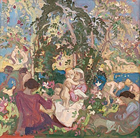 |
| Clock Design (A1822), c1930, pencil, crayon and watercolour on tracing paper, 82x123.5cm, inscribed 'painted silver panel', 'rail', and 'Can we have a square face/this is the best design. FB'.. Provenance: Edgar Peacock; Liss Fine Art. The drawing serves as an indication of Brangwyn's attention to detail. Image courtesy Liss Fine Art. | Foley (C1801), c1934, Foley Pottery bone china. The Foley and Royal Staffordshire Potteries invited a number of distinguished British artists to create contemporary ceramic designs which were then entrusted to Clarice Cliff and her assistants, and were exhibited at Harrods in October and November 1934. Only one set is known to have been prduced. Compared to the Royal Doulton designs, this is very delicate as befits bone china. Image courtesy Liss Fine Art. | Painted Screen (F4830), 1935-1936, 2 oils on canvas, each 136x126cm, set into a three part folding frame, each canvas inscribed: 'To my friend Robert McQueen Grant/Frank Brangwyn 1936'. Grant was an American businessman of the Pennsylvanian firm of Grant Bryn and Mays. The above is a study for one side of the screen, oil on board, 41x44.5cm, Liss Fine Art. The other oil is from the study African market, oil on card, 63x75cm, Arents House, Bruges. Image courtesy Liss Fine Art. |